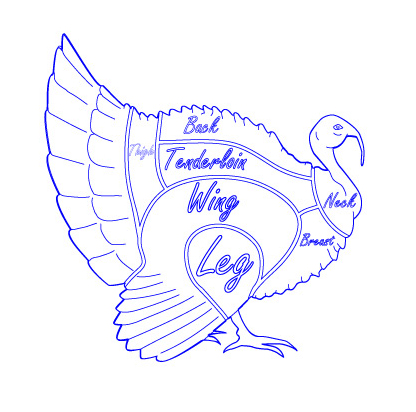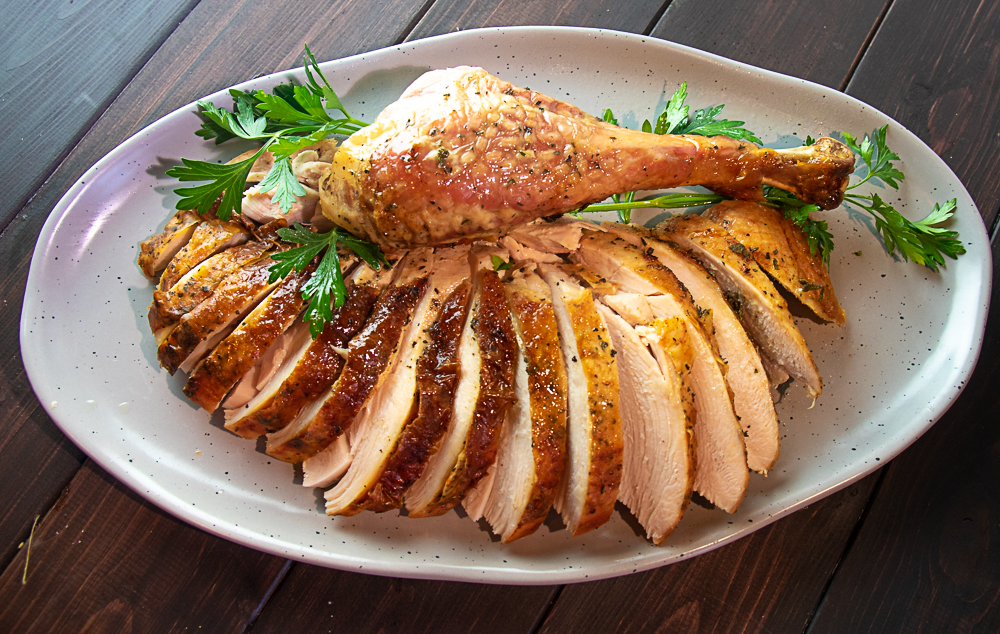
Whether you are a turkey novice or veteran of cooking the bird; there are several decisions you need to make before heading out to purchase the turkey. This turkey primer will help you navigate the options for choosing the right turkey for your Thanksgiving feast.

Turkey Size
Your first decision in this turkey primer is to decide how big of a turkey you need. The rule of thumb is 1 pound per average adult eater of a whole turkey with bones. If you want leftovers, up that to 1.5 pounds per adult. But what if you are feeding a large number of children or older guests who don’t eat as much. I suggest you count any child 12 and up as an adult. Under 12 and older adults plan on 2/3 – 3/4 pound per child or an older adult. If that amount seems extreme, consider that this is the raw weight of turkey which will yield 35% meat when cooked. It also includes the weight of the carcass and giblets.
So you are expecting a large crowd, should you buy the biggest turkey you can get to have enough? The problem with the 25 pound plus birds is actually the size itself. That large of a bird can overwhelm the standard roasting pan and even be too big to comfortably fit in the oven. And trying to lift that size of a hot turkey from the oven in a disposable pan is a recipe for disaster. Better to buy two turkeys or even one large bird and a bone-in turkey breast to equal the weight you need to feed your guests.
On the same note, turkeys weighing less than 12 pounds have a higher bone to flesh rate and actually yield less meat. If you are having a cozy small feast and don’t want a ton of leftovers, consider purchasing just a half breast and a turkey thigh or drumstick instead of the whole bird. Check the meat department and see what turkey parts are available or can be ordered to be picked up just before Thanksgiving.
Fresh or Frozen
Frozen turkeys have been chilled to below 0°F and are readily available now in grocery stores. They are available in a wide range of sizes and are often sold at a steep discount to entice shoppers into the grocery stores. The pros are the price is very low, the convenience of buying the turkey now. The cons are you will need to defrost the turkey for days in the refrigerator (think 4 pounds per day), and frozen turkeys are often injected with a solution that contains broth or water and salt, spices, and other flavor enhancers. They are most likely factory-farmed to produce the largest number of turkeys for the lowest processing cost.
Fresh turkeys come with a bunch of varieties. They are raised organically. The taste is richer, the texture is firmer than frozen turkeys. You will need to order the kind and size you want now and will pay a much higher price per pound (could be $5 plus) for these turkeys. Another drawback is they need to be cooked with three days of purchase (1-2 days is preferred). But the taste is vastly superior to many people. Fresh turkeys are easier to work with since you don’t have the trouble of defrosting. For the many varieties and choices, check your grocery store to see what is available near you.
How to Defrost a Frozen Turkey
There are only two safe methods to defrost a frozen turkey, in the refrigerator or in very cold water which is changed every 30 minutes to keep the temperature cold. Don’t try defrosting a turkey in the microwave or leaving it out on the counter. No one (especially your guests) would want to spend the week after the feast combating a food illness due to improper thawing of the turkey.
Defrost in the Refrigerator
Place the turkey in its original packaging on a tray or container to catch any turkey slush on the bottom shelf of the refrigerator. Plan on 4 pounds every 24 hours to thaw a turkey this way.
Quick (and safe) Defrost method
Completely submerge the turkey in the original packaging in very cold water. Change the water every 30 minutes with very cold water so the turkey surface stays cold. Repeat until turkey has thawed. Plan on 30 minutes per pound to thaw a frozen turkey this way.
What Comes With the Turkey
Whole turkeys often have a pop-up timer inserted. Just pull it out once you unwrap the bird. If you want a dry bird, then definitely use that as your guide. But since you want moist turkey meat, you are going to rely on a meat thermometer instead.

The package will also include the turkey neck in the big front cavity and when you turn the bird, breast side down and check the other end, you will find a package of giblets. These will include the gizzard, heart, and liver, although sometimes you may also find the kidneys.
Grandma would want you to use these to make giblet gravy, I have to admit that the contents on the bag usually are discarded a my house, but I do boil the neck in the turkey stock for my gravy.
Besides buying the turkey, you will need some equipment to cook the bird. Here is a list of basic equipment that you will use for much more than cooking turkeys. Get them now so you are prepared for the grand event.
- Roasting pan
- Thermometer
- Aluminum Foil
- Cooking Twine
- Pastry Brush and/or Bulb baster
Use this turkey primer to choose what type of bird (fresh or frozen) you want . Whether heritage or wild is worth the price. Then determine the size of turkey you want for the number of guests you are expecting. And lastly what to do with the stuff that comes with the turkey. Follow this timeline for figuring out when to start cooking your turkey and enjoy your holiday feast.




Leave a Reply